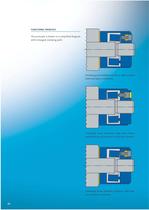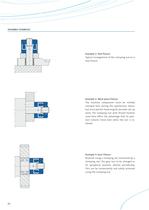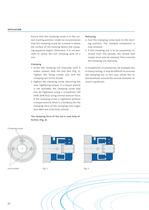Catalog excerpts

SECURE ALL-ROUND CLAMPING FORCE Spieth clamping nuts - an efficient principle. Clamping nuts are widely used in general me- chanical and construction engineering appli- cations as mechanical force-transmitting ele- ments for executing reliable connections involving high axial forces with a low level of manual force. Clamping nuts are suitable for use on rotating spindles and can be clamped and released in rapid succession without dif- Since no movement takes place at the end face and at the main thread of the clamping nut during the clamping process, this precludes the possibility of friction loss. Thanks to the Spieth design, these clamping nuts offer much greater efficiency than conventional nuts - along with an extended service life and resist- ance to temperature influences.
Open the catalog to page 1
CLAMPING NUTS
Open the catalog to page 2
FUNCTIONAL PRINCIPLE The principle is shown in a simplified diagram with enlarged clamping path. Clamping nut screwed into place, light contact with end face is sufficient. Clamping screw actuated: High axial forces have built up at the point of end face contact.
Open the catalog to page 3
SPIETH CLAMPING NUTS AM-GS CLAMPING NUTS During the clamping process (tightening the clamping screw), no movement takes place at the end face and at the main thread of the clamping nut.This precludes the possibility of friction loss, thus eliminating the cause of the poor efficiency of conventional nuts. Only the clamping screw with its relatively small move- ment thread and the ball-bearing supports make some sliding movements. This results in high system efficiency. Combined with the double clamping force ratio, this enables reli- able and user-friendly application of the clamping force....
Open the catalog to page 4
ASSEMBLY EXAMPLES Example 1: Tool fixture Typical arrangement of the clamping nut on a tool fixture. Example 2: Work piece fixture The machine component must be reliably clamped here during the operational status, but must permit traversing for periodic set-up work. The clamping nut with thread fixation used here offers the advantage that its posi- tion remains fixed even when the nut is re- Example 3: Gear fixture Realised using a clamping set, tensioned by a clamping nut. The gear has to be changed or its peripheral position altered periodically. This can be conveniently and safely achieved
Open the catalog to page 5
CLAMPING NUTS SPIETH CLAMPING NUTS SERIES AM-GS
Open the catalog to page 6
Ensure that the clamping screw is in the cor- rect starting position. Under no circumstances may the clamping screw be screwed in below the surface of the housing before the clamp- ing sequence begins. Otherwise it is not pos- sible to utilise the full clamping path of 2 1. Screw the clamping nut manually until it makes contact with the end face (Fig. 1), Tighten the fixing screws and lock the 2. Tighten the clamping screw, observing the max. tightening torque. If a torque wrench is not available, the clamping screw may also be tightened using a screwdriver ISO 2936 (DIN 911) using normal...
Open the catalog to page 7
CLAMPING NUTS All parts are made of steel. The thread ring, the tilting ring and the pressure ring are hard- The outside diameter, the borehole and the end face of the clamping nut are ground. The metric thread d1 is manufactured to toler- ance class "fine" (tolerance zone 5H, DIN 13 The locating bore d2 of the pressure ring is manufactured to tolerance zone H7. The modified clamping screw and the fixing screws are all cheese-head screws with a hex- CONNECTING COMPONENTS The metric bolt thread must normally be man- ufactured to tolerance class "medium" (toler- ance zone 6g, DIN 13 parts...
Open the catalog to page 8All SPIETH-MASCHINENELEMENTE GmbH & Co KG catalogs and technical brochures
-
catalogue
98 Pages
-
Application documentation
20 Pages
-
Radial Plain Bearings
6 Pages
-
Guide Gibs
8 Pages
-
Guide Bushings
16 Pages
-
Clamping Sets
22 Pages
-
Locknut
22 Pages
-
Introduction
11 Pages
Archived catalogs
-
Product Range
8 Pages
-
Tension Nut Type AM
8 Pages
-
Precision Locknut heavy MSW
12 Pages
-
Precision Locknut MSR/MSA
12 Pages




















